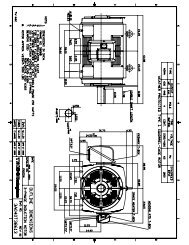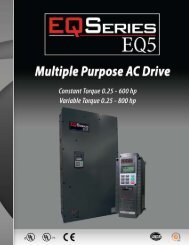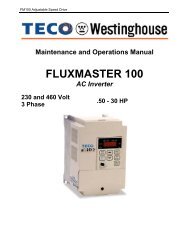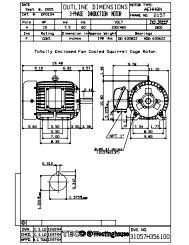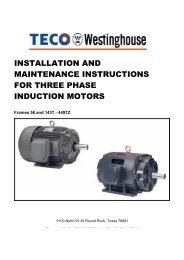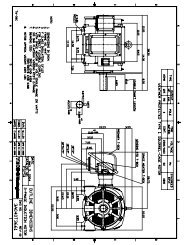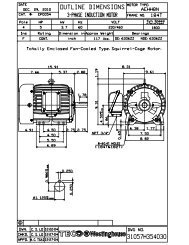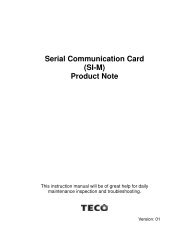EQ7 Series Instruction Manual - TECO-Westinghouse Motor Company
EQ7 Series Instruction Manual - TECO-Westinghouse Motor Company
EQ7 Series Instruction Manual - TECO-Westinghouse Motor Company
You also want an ePaper? Increase the reach of your titles
YUMPU automatically turns print PDFs into web optimized ePapers that Google loves.
Chapter 4 Function Codes / Parameters<br />
Refer to the user manual for function code descriptions not covered in this section.<br />
4.1 Function Code Tables<br />
Function codes enable the <strong>EQ7</strong> series of inverters to be set up to match your system requirements.<br />
Each function code consists of a 3-letter alphanumeric string. The first letter is an alphabet that identifies its group and the following two<br />
letters are numerals that identify each individual code in the group. The function codes are classified into 13 groups: Fundamental<br />
Functions (F codes), Extension Terminal Functions (E codes), Control Functions (C codes), <strong>Motor</strong> 1 Parameters (P codes), High<br />
Performance Functions (H codes), <strong>Motor</strong> 2 (A codes), Application Functions 1 and 2 (J and d), Link Functions (y codes) and Option<br />
Functions (o codes). To determine the property of each function code, set data to the function code.<br />
This manual does not contain the descriptions of Option Function (o codes). For Option Function (o codes), refer to the instruction<br />
manual for each option.<br />
The following descriptions supplement those given in the function code tables on the following pages.<br />
• Changing, validating, and saving function code data when the inverter is running<br />
Function codes are indicated by the following based on whether they can be changed or not when the inverter is running:<br />
Notation Change when running Validating and saving function code data<br />
If the data of the codes marked with Y* is changed with and keys,<br />
Y* Possible<br />
the change will immediately take effect; however, the change is not saved<br />
into the inverter's memory. To save the change, press the key. If you<br />
press the key without pressing the key to exit the current state,<br />
then the changed data will be discarded and the previous data will take<br />
effect for the inverter operation.<br />
Even if the data of the codes marked with Y is changed with and<br />
Y<br />
Possible keys, the change will not take effect. Pressing the key will make the<br />
change take effect and save it into the inverter's memory.<br />
N Impossible —<br />
• Copying data<br />
The keypad is capable of copying of the function code data stored in the inverter's memory into the keypad's memory (refer to Menu #7<br />
"Data copying" in Programming mode). With this feature, you can easily transfer the data saved in a source inverter to other destination<br />
inverters.<br />
If the specifications of the source and destination inverters differ, some code data may not be copied to ensure safe operation of your<br />
power system. Whether data will be copied or not is detailed with the following symbols in the "Data copying" column of the function code<br />
tables given on the following pages.<br />
Y: Will be copied unconditionally.<br />
Y1: Will not be copied if the rated capacity differs from the source inverter.<br />
Y2: Will not be copied if the rated input voltage differs from the source inverter.<br />
N: Will not be copied. (The function code marked with "N" is not subject to the Verify operation, either.)<br />
For details of copying operation, refer to the User <strong>Manual</strong> Chapter 3, Section 3.4.9.<br />
• Using negative logic for programmable I/O terminals<br />
The negative logic signaling system can be used for the programmable, digital input and output terminals by setting the function code<br />
data specifying the properties for those terminals. Negative logic refers to the inverted ON/OFF (logical value 1 (true)/0 (false)) state of<br />
input or output signal. An active-ON signal (the function takes effect if the terminal is short-circuited.) in the normal logic system is<br />
functionally equivalent to active-OFF signal (the function takes effect if the terminal is opened.) in the negative logic system. Active-ON<br />
signals can be switched to active-OFF signals, and vice versa, with the function code data setting, except some signals.<br />
To set the negative logic system for an input or output terminal, enter data of 1000s (by adding 1000 to the data for the normal logic) in<br />
the corresponding function code.<br />
Example: "Coast to a stop" command BX assigned to any of digital input terminals [X1] to [X7] using any of function codes E01 through<br />
E07<br />
Function code data<br />
Description<br />
7 Turning BX ON causes the motor to coast to a stop. (Active-ON)<br />
1007 Turning BX OFF causes the motor to coast to a stop. (Active-OFF)<br />
4-1




